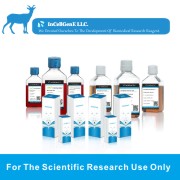

Overview
| Permits and Restrictions | |
|---|---|
| Organism | Homo sapiens, human |
| Tissue | brain; derived from metastatic site: supra-orbital area |
| Product Format | frozen |
| Morphology | epithelial |
| Culture Properties | adherent |
| Biosafety Level |
1
Biosafety classification is based on U.S. Public Health Service Guidelines, it is the responsibility of the customer to ensure that their facilities comply with biosafety regulations for their own country. |
| Disease | neuroepithelioma |
| Age | 14 years |
| Gender | female |
| Ethnicity | Caucasian |
| Applications |
This cell line is a suitable transfection host.
|
| Storage Conditions | liquid nitrogen vapor phase |
Properties
| Karyotype | The cell line is a pseudodiploid human female (XX), with chromosome counts in the diploid range and a modal chromosome number of 46. Normal chromosomes N3 and N10 are absent, and many (N1, N2, N4, N15, N16, N17, N21, and N22) are monosomic. Normal chromosome N8 is most often tetrasomic. The remainder of normal chromosomes were usually paired. Numerous marker chromosomes are present including: 1p+, der(3)t(2;3)(q24;q27), del(4)(p12), 11q+, del(2)(q23), ampl.(17)(p12), ampl.(16)(q13), del(15)(q13q22), 21p+, iso(3q), del(22)(q11q13). Marker chromosomes M2 and M3 appear to us to be identical to two markers (M4 and M3, respectively) described by R.C. Seeger, et al.for this cell line.Ref |
|---|---|
| Derivation |
This is one of two cell lines (see ATCC HTB-11) of neurogenic origin derived by J.L. Biedler. SK-N-MC was isolated in September of l971.
|
| Clinical Data |
14 years
Caucasian
female
|
| Antigen Expression | Antigen expression: Blood Type O; Rh+ |
| Genes Expressed |
Blood Type O; Rh+
|
| Tumorigenic | Yes |
| Effects |
Yes, in hamster cheek
Yes, in nude mice
|
| Comments |
This cell line was found to have moderate dopamine - beta - hydroxylase activity as well as formaldehyde induced fluorescence indicative of intracellular catecholamines.
|
Background
| Complete Growth Medium |
The base medium for this cell line is ATCC-formulated Eagle''s Minimum Essential Medium, Catalog No. 30-2003. To make the complete growth medium, add the following components to the base medium: fetal bovine serum to a final concentration of 10%. |
|---|---|
| Subculturing |
Volumes are given for a 75 cm2 flask. Increase or decrease the amount of dissociation medium needed proportionally for culture vessels of other sizes.
Subcultivation Ratio: A subcultivation ratio of 1:6 to 1:12 is recommended
Medium Renewal: 2 to 3 times per week
|
| Cryopreservation |
Freeze medium: Complete growth medium supplemented with 5% (v/v) DMSO
Storage temperature: liquid nitrogen vapor phase
|
| Culture Conditions |
Atmosphere: air, 95%; carbon dioxide (CO2), 5%
Temperature: 37��C
|


